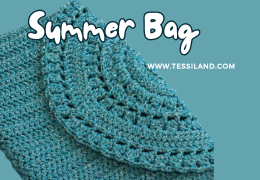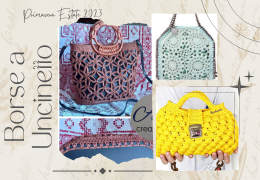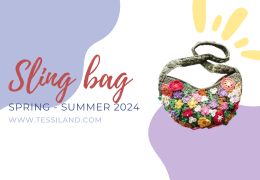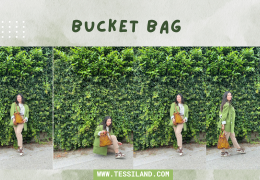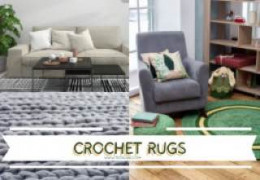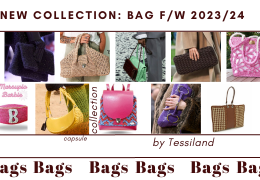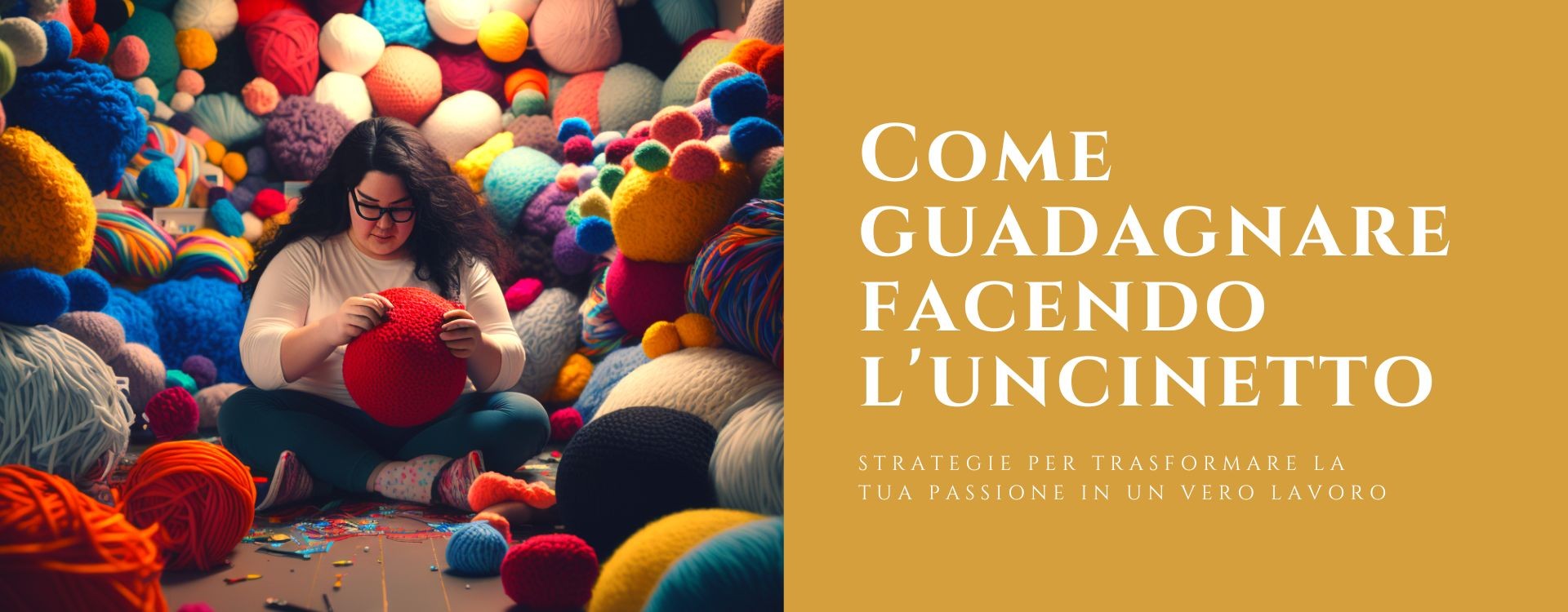Two bags, two styles, one single trend. The Japanese knot takes over summer 2025 with two irresistible crochet...
How to start making money with crochet
Do you want to turn your passion into a job?
Discover how to start without making “false starts” and not waste time and money.
Hi! I’m Giovanni and I’m one of the marketing experts at Tessiland. I will guide you through this little tour to turn your passion into a real business! Follow my reasoning and ask me your questions at the end of the article… I’ll be happy to answer them!
How many times have you wondered: can I turn this passion into a job?
It’s a real dilemma that many people face! Beyond slogans like “do what you love and you’ll never work a day in your life”, we need to take a leap into reality and understand if a business activity can actually be combined with the passion for Handmade.
First of all, we need to ask ourselves a few questions:
- How much time can and do I want to dedicate to this passion?
- How much do I want to invest in this passion?
- Do I want it to become my main job?
- Have I already identified channels to sell my products?
- Do I want to sell only the products or also my knowledge?
Let’s analyze point by point:
How much time to invest in crochet?
Time is the first real investment that requires very accurate planning. You will not achieve any lasting result except through continuous proactive work. The first ingredient for success is consistency and rhythm!
Before starting, learn to consider an editorial calendar with themes, ideas, and projects for a medium to long period that allows you to have some “creative ground” already clear and then … to work!
Do I intend to invest in this passion for crochet & Knitting?
The second point to analyze is whether I have investments to allocate to the passion: materials, space, educational supports, equipment, and social/web organization. In fact, a minimum of financial planning is necessary to avoid “running out of breath” during the process and therefore making a small “business plan” on what I might need for the medium term because it is natural that earnings will not come immediately: the market is ruthless, full of proposals and does not wait for us!
It is necessary to make a quality product, accessible to the largest number of people, and presented in an original and attractive way.
The first step is to choose reliable suppliers who provide continuity and do not leave us halfway with possible orders or who are able to provide information on product restocking with a ready and reliable support service that answers your questions.
There are many realities on the market, but the choice will be fundamental to success and to always have new proposals that can keep us on the “creative wave”!
Not secondary in the historical moment we are living is the degree of sustainability with which your favorite suppliers work and not least the quality and origin of the products.
Emphasizing a mulesing free or ecological product, a Made in Italy and artisanal product has an added value that you should consider if you want to stand out from the crowd and not just engage in a price war.
Create your own Creative Corner
Another fundamental thing is to allocate an exclusive space, even small, but that is your creative corner to set up over time with useful things for your path and that is a bit of your refuge for relaxation and work.
Our creative corner will then be equipped with possible research and educational material that can give us ideas and be motivational (you can’t imagine how important it is to have a pen holder that we like with special pens, for our exclusive use, or a container that holds our work tools like crochet hooks of all sizes and categories or some good text to display during meetings with your potential clients).
Finally, but not least, the equipment! Yes, non-too-professional equipment that can best highlight our creations. Yes, because whether you like it or not, to sell, you will need to generate images that highlight your work! First, a surface to immortalize your products, a decent light source, and a tool capable of taking decent photos and videos.
Fortunately, what seems to be the most important investment remains the simplest because we all now have a smartphone capable of taking photos worthy of being published, and for lighting systems, there are lamps and boxes that can, for a few euros, put us in a position to take almost professional photos.
Having taken this first step, you will need to learn to use some software to create banners and images with writings and slogans, and there are really many for both smartphones and desktops, but one of the most efficient remains Canva.
Practical advice: Canva is free software for basic functions (which are absolutely numerous!) and will allow you to create banners, graphics, and edit your photos without any graphic skills!
Do I want crochet to become my main job?
This question is often answered with yes because it is seen as a last resort. Oh no! It’s not the right approach. This, if it has to be your profession, must be with the same motivations and the same commitment as someone starting their own business, whether it’s a bar, a newsstand, or a store!
If you enter this mindset, you will more easily accept the difficulties that will obviously arise and the sacrifices you will undergo, but you will have the right reward when you reach your goals because it’s scientific: with commitment and dedication you will succeed!
What are the sales channels for my crochet and knitting products?
Once we have established the fundamental bases for starting the business, we must ask ourselves the question: and where do I sell them? It is certainly not a secondary problem! But there are different solutions to this issue: first of all, always remember that the presentation of our products is fundamental: showing that we care about what we produce adds value to it!
For example, a crochet pouch will be more interesting if delivered in a nice package, perhaps with our tag, or with a woven label “handmade”, for example, a tag that explains its qualities, and taken care of in every detail.
It is important to be able to guarantee that your product was made with a quality cord and materials, even better if Made in Italy, let’s create the right emphasis when presenting our creations and guarantee assistance in case of problems with the products (returning to the concept that our suppliers must be reliable!).
But where to sell my handmade creations?
If we have followed the advice in the first part of the article, we will also have tools and software capable of guaranteeing a quality image of our product, so we can first evaluate some marketplaces: one of the most popular is Etsy for the “handmade” world, but nothing prevents us from also using more renowned marketplaces such as Amazon or Ebay for example!
Another solution, among the most appreciated by creatives embarking on this entrepreneurial path, is the “sale on consignment at clothing stores”. You can therefore do some research in your city looking in shop windows for who might be interested in a handmade product (and there are many because it’s trendy!!!) and try to introduce yourself to find your customers…but ATTENTION: the shopkeeper is not waiting for you, so announcing yourself with an appointment and with some products made to show is very important!
If we want to be considered, we must present ourselves as professionals who believe in their work and not as hobbyists who are here today and gone tomorrow; we are asking for an investment in our creativity and we must provide guarantees of continuity if the business takes off!!!
Do I want to sell products or also my knowledge?
Another very popular topic among enthusiasts. But then, how much do you earn on YouTube if I create a creative channel? Unfortunately, with the spread of social networks, it is increasingly difficult to achieve noteworthy earnings, but if seen as a “side” to a main activity, then they can become interesting.
Earnings will depend on the views of the published projects and therefore we return to the points discussed earlier: quality images, and explanations within everyone's reach! Creating original projects will not be enough to stand out; it will be an important component but not the only one necessary. Consistency will be needed as the first ingredient, to build loyalty among your followers to the content and to have a lot of patience!
We will also need to consider working on the most important social networks (Facebook, Instagram, Pinterest, and TikTok) to spread our BRAND as much as possible, yes, because our path must be preceded by a Brand that identifies us and makes us unique, original, and as little as possible “copied” from more famous brands (this would put us on a lower level right from the start…we are unique and we want the world to know it! Much better my name and surname than referring to famous channels like the corner of... or all-around woman... originality is our first goal!
Practical advice: one way to start studying a brand could be Namelix, free software that, based on some parameters you enter like your name, the essential characteristics of what you want to propose, or even a fantasy name, will develop a series of proposals not only for a Brand but also graphics for your next Brand! Very interesting!
The tools of the trade to start working with crochet professionally
Another detail not to be overlooked is using, in addition to the right tools to produce and post-produce your content, quality tools. Crochet is relaxing, knitting too, but if we have to dedicate hours and hours every day, these activities are also exhausting like any manual work! And here we often read about inflamed nerves, carpal tunnel, and sore shoulders.
How to solve posture problems for crochet work?
We must start with a comfortable workstation and perhaps ergonomic (there are very comfortable “gamer” chairs available at interesting prices that allow for a comfortable seat and armrests, which in the long run will not be a detail!).
Then use tools that make the movement as smooth and easy as possible. Even a very simple crochet hook can make a difference and it’s proven! Those who use this magical tool for a few hours can be satisfied with the classic aluminum crochet hook for a few cents, but those who use the crochet hook for many hours a day cannot do without ergonomic and smooth crochet hooks where even the friction with the yarn is studied in the laboratory!
For example, one of the best crochet hooks on the market is from a Japanese brand that uses special (and secret!) metal alloys that have made it a real object of desire and silicone materials for the grip that have nothing to do with the rest of the tools on the market: I'm talking about CLOVER!
What are the best knitting needles on the market?
The same applies to knitting needles and circular needles. If we do it as a hobby, we can be satisfied with commercial knitting needles that, with a minimum expense, allow us to work or take the first steps in the knitting world, but if we want to pursue the work continuously, we will have to evaluate the top articles that allow us to work smoothly and comfortably.
Without a doubt, one of the most innovative products is the ergonomic Prym needle which, with a particular structure, a tip with a truly unique design, and a very low specific weight, will allow maximum comfort and a 30% higher execution speed compared to a traditional needle, not to mention some features such as the ergonomic tip that will never make you lose a stitch again!
For circular needles, the discussion shifts to Knit Pro, which with its quality and a wide range of accessories will allow us to enrich our toolbox over time with the interchangeability of cables, connectors, and various accessories that should not be underestimated. Make your choice!
10 Strategies to start selling crochet or knitting works
- Define your target audience and develop a specific niche.
- Create a portfolio of high-quality products and present your creations on e-commerce platforms like Etsy or DaWanda, Amazon, or Ebay.
- Develop a social media presence to promote your brand and increase visibility.
- Participate in local fairs and markets to get known by the public and sell your products.
- Offer personalized and custom options for your customers.
- Build relationships with your customers through communication and high-quality customer service.
- Take advantage of collaboration opportunities with other artisans or local shops.
- Develop a strong and professional online presence, with a well-designed website or a good, updated, and proactive social media page.
- Learn about tax laws and manage taxes correctly to avoid future problems.
- Continue to improve your skills and learn new techniques to keep your offer current and interesting for customers.
Having clear ideas about what to propose at the beginning
Returning to the first point of the list just made, it is advisable to give a precise identity to our works. Identify the range of creativity we want to propose with defined limits to be perceived as a professional (for example, amigurumi or crochet bags or trendy knitted sweaters, for example).
Identify, in addition to a reliable supplier, also the flagship products on which to offer, for example, different color nuances or textures.
Preparing a winter collection for crochet or knitting:
We start with the classic merino wool if we want to give a quality image, maybe combine it with a good wool blend and maybe an acrylic microfiber for customers who might request alternatives to animal fibers.
From these products, over time, create a kind of color palette to propose (and in this case, a shop like Tessiland is ideal, selling the product by single ball… so as not to face significant investments at the beginning, also thanks to the shipments that Tessiland has been doing “always and forever” with only 19 euros of order, which in some cases becomes really fundamental! Not to mention the speed of this shop that allows you to commit to customers without worries).
Preparing a summer collection for crochet and knitting:
Surely a mercerized gassed cotton Made in Italy is the starting point! If it has a wide range, even better, if it has a competitive price…GREAT! And in this case, the most suitable item to start with is undoubtedly IGGY! Over 50 colors of 100% cotton always in stock to make everything from clothing to amigurumi!
You can’t miss putting in the collection the classic Filo di Scozia. 100% mercerized gassed cotton as well, but with a much tighter yarn twist that not only lends itself to clothing but also to accessories like doilies, gadgets, curtains, jewelry, or runners. In this case, the yarn to recommend could be Amanda, a No. 5 cotton among the best-selling in Europe and exclusively produced by Tessiland (naturally on the portal, there are also cottons No. 8-12-16 and 25).
Finally, for a need that is of quality but very competitive with the price, you could opt for a 100% recycled cotton also 100% Made in Italy but with an incredible price and a very interesting color range: DRAKE.
Preparing a fancy yarn collection for crochet and knitting:
A section that we must dedicate to the fashion yarn certainly needs to be considered, and in this case, the choices will have to be based on personal taste and the taste we want to give to our collection. We could point out some of the most popular and those that could best represent the completion of this handmade “capsule”.
We could recommend a Bucley, fluffy and fashionable colors with lurex inserts that can be a protagonist in knitwear but also accessories like scarves, baktus, and stoles.
Perhaps a quality shaded yarn like Superkate to satisfy those looking for a color match to their style or outfit and finally maybe a more “chic” yarn with sequin inserts for special events like weddings or important dinners such as SLEEPY.
The choice is vast on Tessiland and will depend exclusively on the taste of the creative and the final customer.
Legal obligations and taxation

Do I need a VAT number to sell my products?
Oh yes, because the story of occasional performance that has sparked the birth of many brands, YouTube channels, and creatives is OVER! Today if you want to do any activity, even those considered by many as simple home hobbies, you must comply with the regulations.
The story of the 5000 euros per year ended at the end of 2021 and from December 2021 the regulation has changed and anyone monetizing (no matter how much) from a YouTube channel or sales to stores must comply.
Even the markets are regulated, but amidst provincial and municipal laws, there is still some confusion, but let’s prepare ourselves with the awareness that if you want to sell, you must comply!
So VAT number or individual company, these will be personal decisions and of our accountant, but you can no longer pretend to ignore without being a tax evader.
Let’s analyze some basic concepts to sell our products
Let's start by saying that anyone who does a commercial activity that can be defined as “continuous” must open a tax position (VAT number).
On the other hand, if you sell a personal item occasionally, in that case, no, a VAT number is not needed (if, for example, we have a chandelier that we don't need and sell it to our neighbor, in that case, naturally, no VAT number is needed).
When our products can be defined as artistic works (imagine making a completely original mosaic painting), and anyway the exclusive result of one's creative genius and especially when the activity is carried out in a non-professional manner (therefore without organization and continuity over time), even in that case the sale without VAT is not provided.
Here we should delve into the intricacies of the law that distinguishes artistic production in general and therefore distinguishes hobbyists from creatives. Simply put, we should know that to be classified as a hobbyist, you create a product starting from existing materials, assemble them, modify them, and especially do not do it continuously.
The figure of the creative, on the other hand, is identified in that professionalism dedicated to the realization of everything completely original, for which one can also claim copyright.
After this brief specification (but still superficially because each case should be analyzed individually) the hobbyist is not required to have a VAT number not only because we could define her as a “transformer” but also because she is not dedicated to the exercise of a continuous and professional activity, it goes without saying that the creative, on the other hand, yes, must have a VAT number to sell her works.
Without delving further and reiterating that the considerations are general and should therefore be applied to the specific case by a professional, 99% of people interested in selling their products are of the first type, the Hobbyists, and this will be the subject of my in-depth analysis.
What are the rules for selling crochet products
Unfortunately, there is no real national regulation for this activity but some principles are established and this is where we will start:
The value of a single creation or work must not exceed 250 euros (although for this parameter we must consider regional regulations that may state different values).
But let’s take this first data as a starting point for “identifying ourselves” and after putting down the first marker, it must be emphasized once again that the activity to NOT be subject to taxation regimes MUST NOT be continuous and MUST NOT be carried out professionally, therefore it must be an amateur activity.
Once these first criteria are clear, yes, we can say that we must not exceed 5,000 euros a year in revenue (but this in the past was erroneously considered the only requirement…FALSE! This is one of many.).
A non-fiscal receipt must still be issued (akin to the classic receipt and can be issued by private individuals).
To fill it out, there are pre-printed models, but it is also possible to create pre-printed forms ourselves, bearing in mind that the law does not require a tax stamp up to a value of 77.47 euros (our old and beloved 150,000 lire).
Therefore, once this amount is exceeded, a 2 euro tax stamp must be applied!
Moreover, it should be noted that even if the non-fiscal receipt cannot be considered a real tax document, it is mandatory to keep them to later complete your tax return! Oh yes, because not opening a VAT number does not mean not declaring additional income to the tax authorities.
Generally speaking, if your income (including any earned as an employee) does not reach 5000 euros, then you could be exempt from the declaration; otherwise, it will be declared as other income (Income referred to in article 67, paragraph 1, letter i) of DPR n 917/86, (box D of the 730 model or box RL of the Personal Income Tax model), the compensation received from the sales of handmade objects.)
Selling products at markets without a VAT number
Another question we are often asked. In principle, even without a VAT number to sell at a small or large market, you need to inquire about municipal rules. In fact, in this case, each municipality adopts its own regulation on the necessary permits.
In case of inspection, a Substitute Declaration of Affidavit will certainly have to be presented. A declaration that every hobbyist should (MUST) present to the organizing municipality of the event, whether it is a fair, market, etc.
In some Regions, it is also necessary to have a “Hobbyist Card”. A kind of “hunting license” (pardon the joke) with regulations as varied as our territory, so it is necessary to know that it exists but also to understand if your region of residence provides for it.
Online sales of crochet and knitting creations and products
For this chapter, there is much confusion, and even if regulations exist, they are rarely applied, to the detriment of those who comply, unfortunately. But here I must explain what needs to be done, not what actually happens, so:
know from the start that online sales, therefore the display of a product with a description, characteristics, and price necessarily requires a tax position! You understood correctly, you need a VAT number that must be, among other things, clearly visible on the homepage of your site.
So? Can’t I make a site if I don’t have a VAT number?
You can’t do it if you intend to sell your products with a displayed price continuously. For this reason, the site will be feasible, but exclusively as a showcase site, to advertise and create an audience before deciding to do it continuously and professionally.
Can I sell my creations on Marketplaces?
Not to be repetitive, but unfortunately, it is so: Etsy, Ebay, DaWanda, Subito, MissHobby, Amazon, or any third-party platform will be fine for selling your products without a VAT number…UNTIL…your activity becomes continuous. This makes you understand that if “once in a while” you sell something, you can stay calm, but if you want to do business, there’s no escape….the taxman is watching you!
Selling Handmade Items to Stores with a Consignment Agreement
This is one of the most immediate and fastest practices to earn and also find some satisfaction immediately (I talked about it above).
It simply and somewhat simplistically consists of a agreement between a store owner and a hobbyist who offers handmade items for a pre-set price that the store owner will then resell with a margin. After the sale, the hobbyist will be paid, otherwise, the unsold product will return to the hobbyist at no cost to the store owner.
Even in this case, it turns out to be a great approach to understand the direction to take, if your style is liked and if there is feedback from customers, and if, above all, the opening of a tax position can be sustainable.
Conclusions
As you may have seen, there are many things to know if you want to turn this passion into a real job, and I couldn’t go into detail, but I feel like giving my personal opinion for what it’s worth.
In my experience at Tessiland, I have had the privilege of meeting many creatives and enthusiasts, and I can say without fear of contradiction that the only, essential, most important, essential element to do anything is commitment.
Believing deeply in your project will allow anyone to achieve the desired results.
Commitment, dedication, and passion will be the ingredients and there will be no VAT number that holds because even taxes can be nice to pay if they then allow us to express our passion, our art, yes because it is art, and to receive satisfactions that have little or nothing to do with remuneration…and then…that too will come!
Good luck and happy creativity!
Giovanni Mustone.



